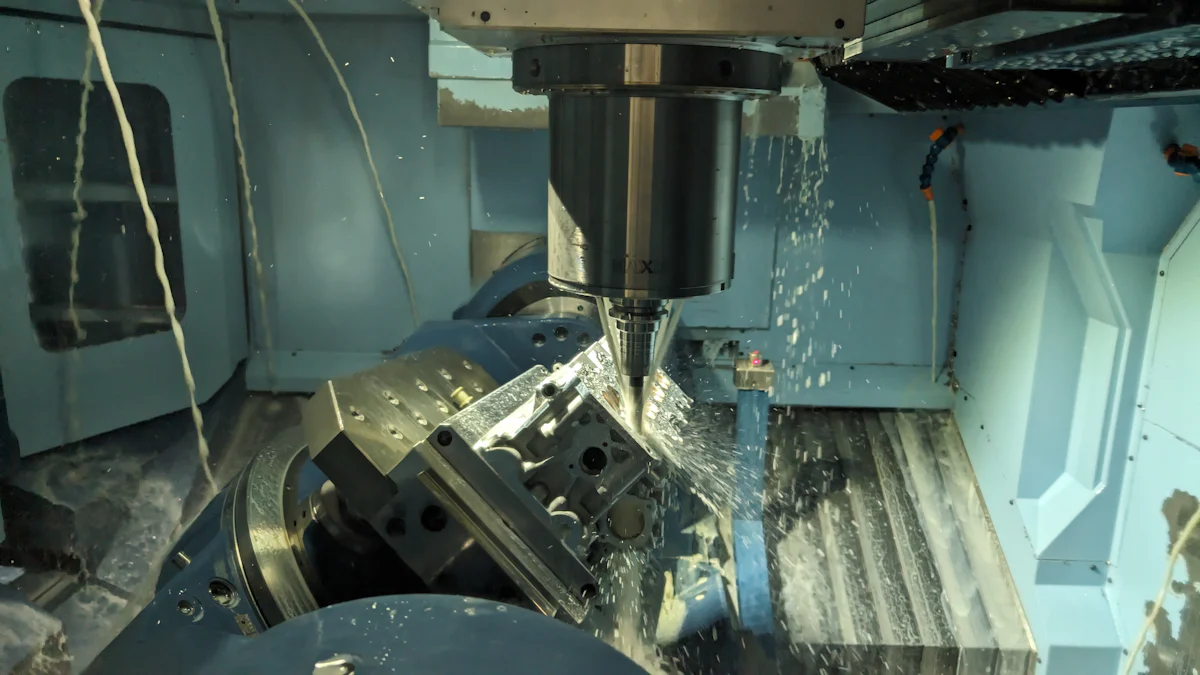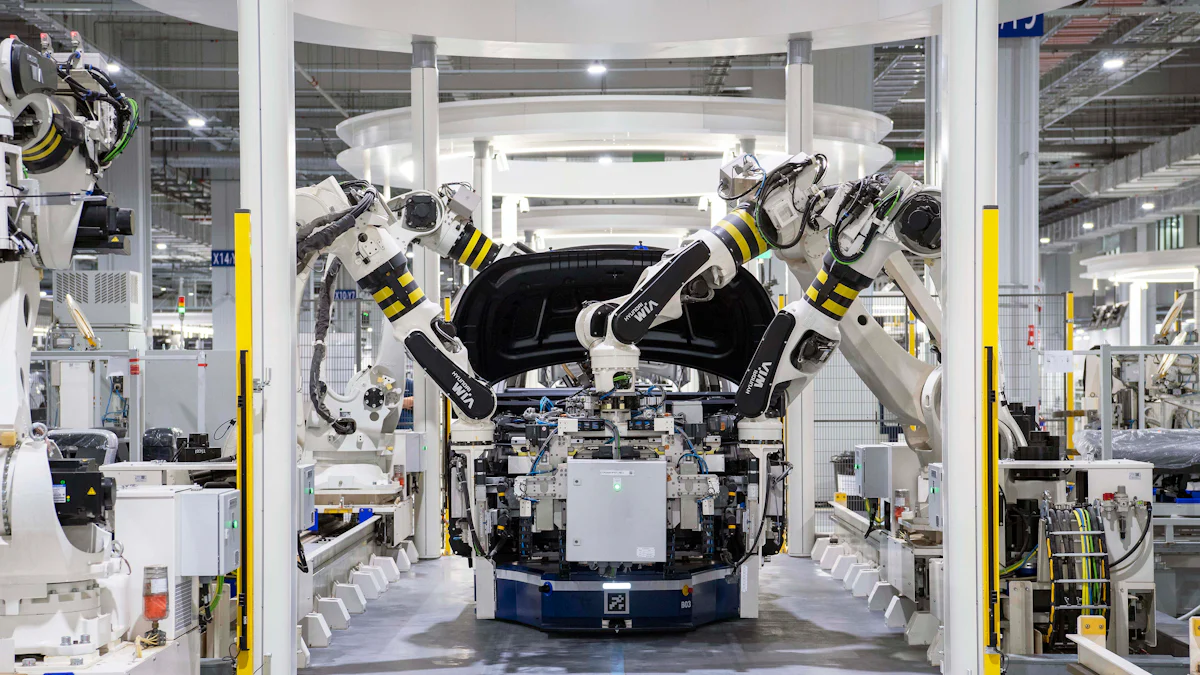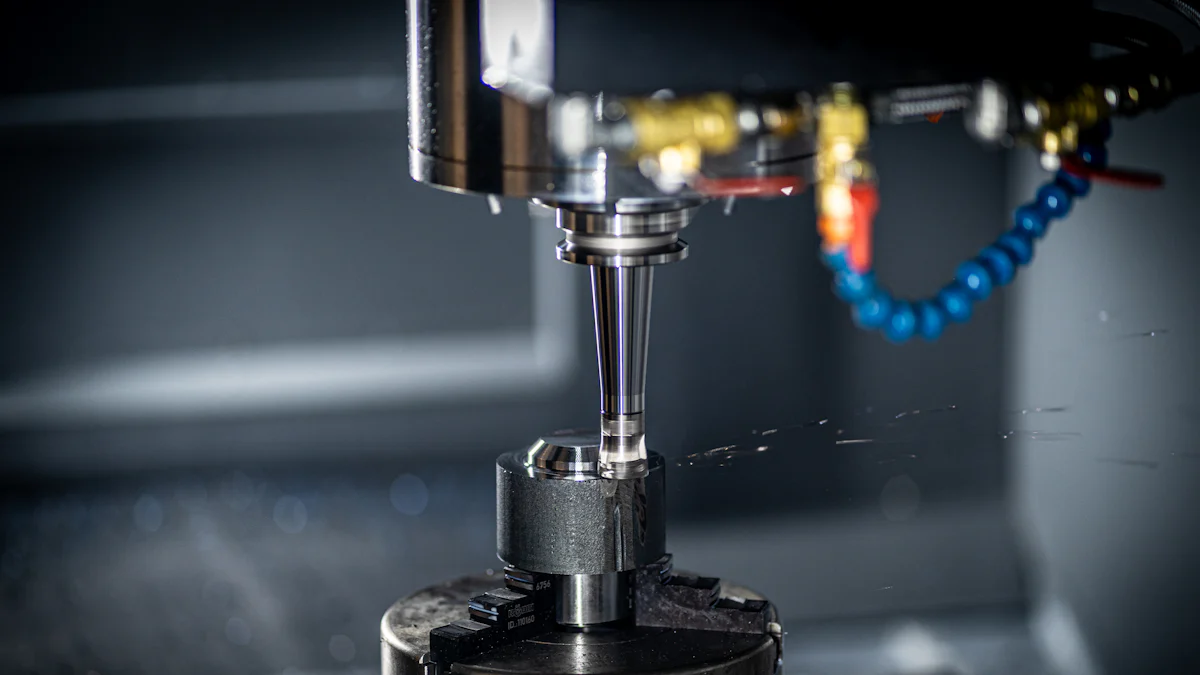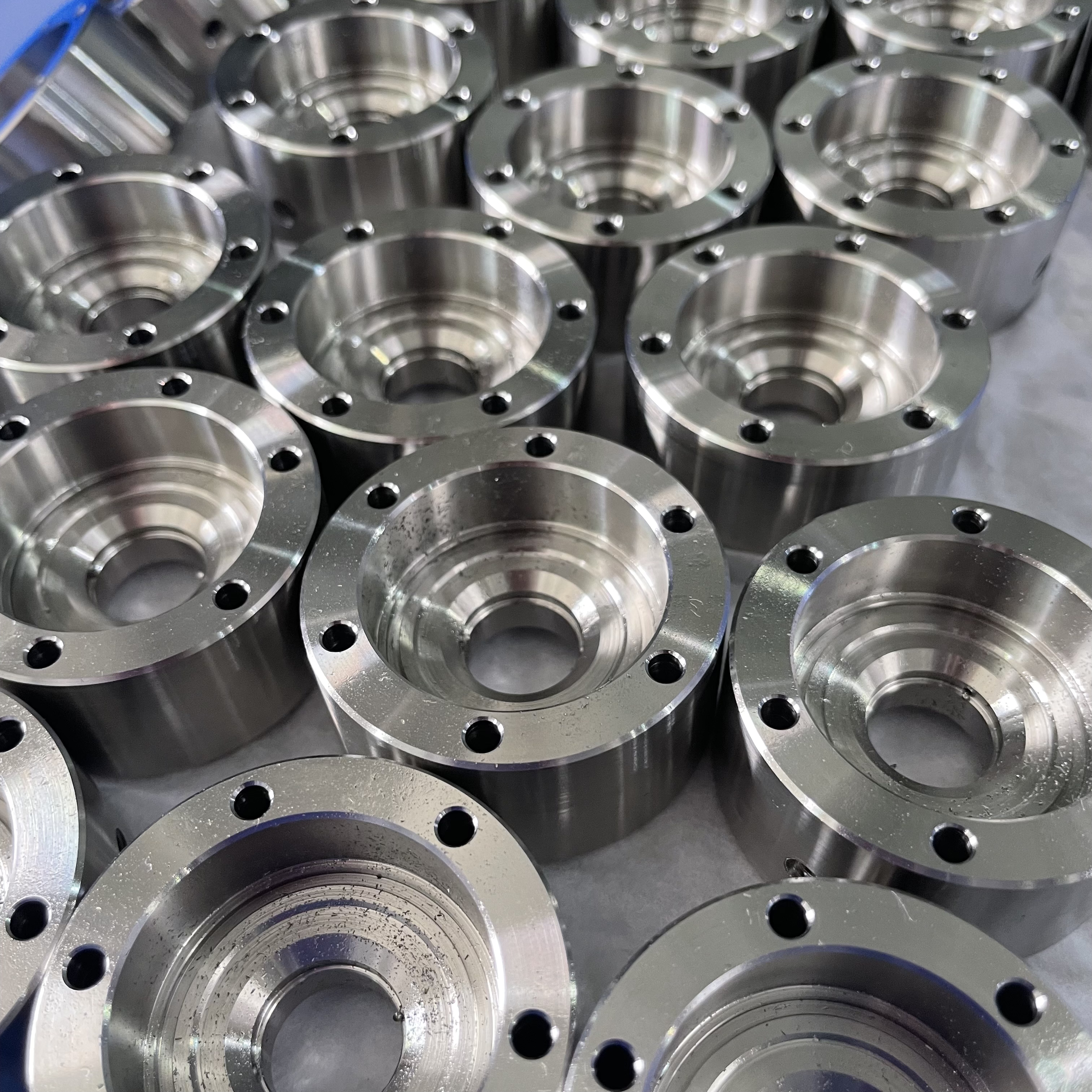Why You Should Consider CNC Machining for High-Volume Production Runs

CNC machining provides a reliable solution for high-volume production. You can achieve unmatched precision and consistency, even for complex designs. Industries like aerospace and automotive rely on this technology to meet tight tolerances, such as ±0.0001” for critical components. Automation reduces labor costs and minimizes errors, leading to significant cost savings. The global CNC machines market is growing rapidly, projected to reach $170.4 billion by 2033. This growth reflects its ability to handle increasing demands for customization, efficiency, and sustainability. By adopting CNC machining, you can streamline production and stay competitive in evolving markets.
Key Takeaways
CNC machining is very accurate and consistent, perfect for making many parts with exact measurements.
It uses machines to lower worker costs and waste, saving money and speeding up production.
CNC machining can make more or fewer parts as needed, helping businesses stay flexible.
It works quickly and efficiently by using good schedules, upkeep, and smart tools.
Picking the best materials and suppliers is important for good quality and saving money.
Understanding CNC Machining for High-Volume Production

What Is CNC Machining?
CNC machining, or Computer Numerical Control machining, is a manufacturing process that uses automated tools to create precise components. You start with a digital design, often created using CAD (Computer-Aided Design) software. This design is then converted into G-code, a machine-readable language that directs the CNC machine's movements. The machine tool follows these instructions to shape raw materials into finished products.
This process automates the control of equipment like lathes, mills, and routers. Unlike manual machining, CNC machining ensures repeatability and accuracy, making it ideal for industries requiring tight tolerances. The core components of a CNC system include the controller, machine tool, drive system, and feedback system. Together, these elements deliver precision, consistency, and productivity.
How High-Volume CNC Machining Works
High-volume CNC machining involves a streamlined workflow to produce large quantities of parts efficiently. The process begins with understanding customer requirements and creating CAD models. These models are converted into G-code through CAM (Computer-Aided Manufacturing) software. Next, raw materials and tools are prepared, and the machine is set up with the correct program and fixtures.
Once the setup is complete, the CNC machine executes the machining process. During this stage, the cutting tool removes excess material to form the desired shape. After machining, finishing steps like deburring, polishing, and quality inspections ensure the final product meets specifications. This workflow allows you to achieve consistent results, even for complex designs, while reducing lead times.
Why CNC Machining Is Ideal for High Volume Production
High-volume production machining offers several advantages over traditional methods. CNC machining excels in speed, producing parts faster to meet tight deadlines. Its accuracy ensures components meet exact specifications, reducing errors and rework. The scalability of high-volume CNC machining allows you to adjust production levels based on demand, making it a flexible solution.
Technological advancements further enhance its suitability for high-volume production. High-performance cutting tools and optimized tool geometries reduce machining time. Adaptive tool control systems automatically adjust settings for optimal performance, minimizing bottlenecks. Additionally, IoT-enabled remote monitoring ensures real-time oversight, reducing downtime and improving efficiency. These features make CNC machining a reliable choice for high-volume production machining.
Benefits of High-Volume CNC Machining
Precision and Consistency in Manufacturing
CNC machining ensures precision and consistency, which are essential for high-volume production. You can rely on CNC machines to achieve tight tolerances, often within a thousandth of an inch. This level of accuracy is critical in industries like aerospace and medical devices, where even minor deviations can compromise functionality. CNC machining also guarantees repeatability. Whether you produce the first or the thousandth piece, the results remain identical. This consistency eliminates variability, ensuring every part meets the same high-quality standards.
Automated processes in CNC machining further enhance precision. Advanced software controls the cutting tools with exact movements, reducing the risk of human error. This approach allows you to produce precision machined components with unmatched accuracy. By maintaining strict quality control throughout production runs, CNC machining delivers reliable results for high-quality machining.
Cost Savings Through Automation
Automation in CNC machining significantly reduces production costs. You can minimize labor expenses by relying on machines instead of manual labor. CNC machines operate faster and more efficiently than traditional methods, enabling you to complete production runs in less time. This efficiency leads to higher output and faster turnaround times.
CNC machining also optimizes material usage. Automated processes calculate the most efficient cutting paths, reducing waste and lowering material costs. Additionally, the ability to produce complex parts quickly reduces lead times, allowing you to meet tight deadlines without compromising quality. These factors contribute to substantial cost savings, making CNC machining an economical choice for high-volume production.
Scalability for Large Production Runs
CNC machining offers scalability for any production volume, making it ideal for large production runs. You can integrate multiple processes, such as cutting, drilling, and grinding, into a single workflow. This integration increases speed and efficiency, enabling you to complete larger tasks with fewer machines.
The automation of CNC processes ensures consistent quality and accuracy, even for extensive production runs. This reliability allows you to scale up production without sacrificing precision. Additionally, CNC machining supports cost savings associated with mass production. By reducing labor costs and maintaining high production machining standards, you can meet volume manufacturing requirements effectively.
CNC machining adapts to your needs, whether you require a small batch or a large-scale operation. Its flexibility and efficiency make it a valuable solution for high-volume production.
Efficiency and Reduced Lead Times
CNC machining enhances high volume production by delivering faster turnaround times and improved efficiency. You can achieve this through several key practices:
Effective scheduling and job allocation ensure machines operate at maximum capacity.
Regular maintenance keeps equipment running efficiently while minimizing downtime.
Upgrading technology improves machining capabilities, allowing for shorter lead times.
Robust quality assurance processes catch errors early, reducing costly reworks and scrap rates.
Digital quality systems provide real-time monitoring and automated inspections, streamlining workflows and accelerating production.
These strategies allow you to optimize operations and meet tight deadlines without compromising quality. By implementing these methods, you can handle high volume production demands with ease. CNC machining’s ability to deliver consistent results quickly makes it a valuable tool for businesses aiming to stay competitive.
Environmental Benefits and Reduced Waste
CNC machining supports sustainable manufacturing by promoting resource efficiency and minimizing waste. This process optimizes material usage, ensuring you use only what is necessary to create each part. Recycling and reusing materials further reduce waste, helping you achieve sustainability goals while lowering costs.
Energy conservation plays a significant role in CNC machining. By adopting energy-efficient technologies, you can significantly reduce energy consumption during high volume production. This not only lowers operational costs but also decreases the environmental footprint of your manufacturing processes.
Additionally, CNC machining integrates environmentally friendly practices that comply with regulations and reduce ecological impact. These practices include advanced waste reduction strategies and precision engineering techniques that minimize scrap. By choosing CNC machining, you contribute to a greener future while maintaining high production standards.
High-Volume CNC Machining vs. Traditional Methods
Comparing Accuracy and Quality
CNC machining surpasses traditional methods in both accuracy and quality. You can achieve tight tolerances of ±0.001 inches, ensuring precise and consistent results. Traditional methods often struggle to maintain such precision, leading to variability in output. CNC machining also excels in repeatability. Every part produced is identical, which is critical for high volume production.
Feature | CNC Machining | Traditional Methods |
|---|---|---|
Tight Tolerances | ±0.001 inches | Varies |
Repeatability | High (identical parts) | Lower consistency |
This level of precision reduces errors and enhances productivity. By choosing CNC machining, you ensure superior quality control and minimize the risk of defective parts. These advantages make it the preferred choice for industries requiring high standards, such as aerospace and medical manufacturing.
Speed and Efficiency in Production
CNC machining significantly improves production speed and efficiency. Once programmed, CNC machines operate autonomously, reducing the need for constant supervision. Multi-axis CNC machines can perform multiple operations simultaneously, saving time and increasing output.
CNC machining enhances manufacturing speed compared to traditional methods.
Autonomous operation minimizes the need for manual oversight.
Multi-axis machines execute various tasks at once, streamlining production.
Faster project completion reduces lead times and boosts cost efficiency.
These features allow you to meet tight deadlines without compromising quality. For high volume production, CNC machining ensures quicker turnaround times and optimized workflows, making it an invaluable tool for businesses aiming to stay competitive.
Long-Term Cost-Effectiveness
CNC machining offers cost-effectiveness in the long run by reducing labor and material costs. Automation minimizes manual intervention, enabling one operator to manage multiple machines. This reduces labor expenses while maintaining high productivity.
CNC machining also optimizes material usage. Precise cutting paths minimize waste, lowering overall production costs. Faster turnaround times further enhance profitability by enabling quicker delivery of products. These factors contribute to sustainable manufacturing practices and long-term savings.
By investing in CNC machining, you benefit from reduced operational costs and improved efficiency. Although the initial setup may seem costly, the long-term advantages outweigh the upfront investment. This makes CNC machining a smart choice for businesses focused on cost efficiency and scalability in high volume production.
Flexibility in Design and Prototyping
CNC machining offers unmatched flexibility when it comes to design and prototyping. You can create prototypes that accurately represent your final product. These prototypes reveal every specification, allowing you to test functionality and identify potential design flaws. This process ensures your product meets expectations before moving to full-scale production.
You can also experiment with a wide range of materials. CNC machines handle metals like aluminum, steel, and titanium, as well as plastics and composites. This versatility allows you to test prototypes using materials that closely match the final product. By doing so, you gain a better understanding of how your design will perform under real-world conditions. Whether you need rigid or flexible materials, CNC machining expands your design possibilities.
CNC machining’s ability to produce both single parts and large batches makes it ideal for prototyping. You can create one prototype to test a new concept or manufacture multiple units for market testing. This capability is especially useful if you’re introducing a new product and want to gauge consumer response. It also helps when demand for industrial products fluctuates, giving you the flexibility to adapt quickly.
Additionally, CNC machining supports intricate and complex designs. Advanced software and multi-axis machines allow you to create detailed features that would be difficult or impossible with traditional methods. This precision ensures your prototypes reflect the exact specifications of your digital designs. By leveraging CNC machining, you can refine your ideas and bring innovative products to life with confidence.
Practical Considerations for CNC Machining Solutions
Material Compatibility and Selection
Choosing the right material is crucial for successful CNC machining solutions. You need to consider the material's properties, such as tensile strength, wear resistance, and hardness. Environmental factors like heat tolerance, flame retardance, and chemical resistance also play a role. For example, stainless steel works well in harsh environments due to its durability, while ABS plastic offers high impact strength for lightweight applications.
CNC machines can handle a wide range of materials, including metals and plastics. Common metals include aluminum, brass, copper, and steel. Aluminum 6061 is known for its excellent machinability, while 7075 provides high strength and heat resistance. Plastics like PEEK, ABS, and polycarbonate are also popular. Each material has unique characteristics, so you should match the material to your project's requirements.
To select the best material, follow these steps:
Define the part's functionality and mechanical needs.
Research materials commonly used for similar applications.
Test prototypes to evaluate performance.
Factor in cost and secondary processes like finishing or coating.
Tip: Always consider the material's compatibility with your intended application to ensure optimal performance.
Production Volume and Lead Time Requirements
Understanding production volume and lead time is essential for planning CNC machining solutions. High-volume production often requires weeks to complete. For instance, producing 1,000 parts typically takes 3-4 weeks, while 10,000 parts may require 1-2 months. Simple parts can be completed in hours, but complex designs or hard-to-machine materials extend lead times.
Efficient scheduling and material handling can help you meet deadlines. Regular maintenance of CNC machines reduces downtime, ensuring consistent production. By optimizing workflows, you can minimize delays and deliver products on time.
Production Volume | Lead Time Requirement |
|---|---|
1,000+ parts | 3-4 weeks |
10,000+ parts | 1-2 months |
Choosing the Right Supplier for CNC Machining
Selecting the right supplier ensures the success of your CNC machining solutions. Evaluate their capabilities, including machine types and processing strategies. A supplier with advanced equipment and expertise can handle complex designs and high volumes efficiently.
Check their quality systems and certifications, such as ISO 9001. A strong quality assurance process ensures consistent results. Review their performance history and look for evidence of continuous improvement practices like Lean or Six Sigma. Assess their pricing to ensure it aligns with the quality and service provided.
Note: Consider the supplier's compliance with legal and environmental standards to avoid potential risks.
By choosing a reliable supplier, you can streamline production, maintain quality, and meet your business goals.
Evaluating Costs and Return on Investment
When considering CNC machining for high-volume production, evaluating costs and potential returns is essential. Understanding the factors that influence expenses helps you make informed decisions and maximize profitability.
Several key cost factors impact CNC machining. These include production volume, machining time, and additional services. Larger batch sizes often reduce costs due to economies of scale. Smaller runs may incur higher setup expenses. Longer machining times also increase costs, but optimizing tool changes and setups can help reduce these expenses. Tighter tolerances and finer surface finishes require more operations, which can raise costs. Investing in high-quality tools and equipment may seem expensive initially, but it reduces long-term expenses by improving efficiency and durability.
Cost Factor | Description |
|---|---|
Quantity and Batch Size | Larger production runs are more cost-effective due to economies of scale, while smaller quantities may incur higher setup costs. |
Machine Time | Longer machining processes increase costs; optimizing setup and tool changes can reduce expenses. |
Tolerances and Surface Finishes | Tighter tolerances and finer finishes require more machining operations and specialized tooling, leading to higher costs. |
Tooling and Equipment | The cost varies based on the tools and fixtures required for different operations; investing in quality tools can reduce long-term costs. |
Additional Services and Finishing | Services like surface treatments can add to costs; planning for these in advance is crucial for accurate cost estimation. |
Supplier Selection | Choosing a skilled CNC machining provider can ensure cost-effective and high-quality results. |
CNC machining offers significant cost-saving benefits. Automation reduces labor expenses by minimizing manual intervention. Optimized cutting paths lower material waste, saving resources. Improved cycle times and reduced setup durations enhance production efficiency. These advantages contribute to a higher return on investment, especially for large-scale operations.
By carefully analyzing costs and returns, you can determine whether CNC machining aligns with your production goals. A strategic approach ensures you achieve both quality and cost-effectiveness, making CNC machining a valuable investment for your business.
Industries Leveraging High-Volume Production Machining

Automotive and Aerospace Applications
CNC machining plays a critical role in the automotive and aerospace industries, where precision and durability are essential. You can rely on CNC technology to produce components with tight tolerances, ensuring safety and performance.
Engines: CNC machining creates engine blocks and cylinder heads with unmatched accuracy.
Lighting: Headlights and interior lighting components, often made from PMMA, showcase the versatility of CNC machining.
Transmission Components: Gears and clutches benefit from CNC machining during prototyping, improving their efficiency and lifespan.
Turbine Blades: The technology enables precise shaping of turbocharger components, enhancing engine performance.
Suspension Components: Springs and shock absorbers are manufactured with high precision for optimal safety and comfort.
Exhaust Systems: CNC machining fine-tunes headers and catalytic converters to meet emission standards.
Interior Panels: Designers use CNC machining to experiment with materials and create innovative interior designs.
In aerospace, CNC machining ensures the production of high-precision parts like turbine blades and aircraft frames. These components must meet strict tolerances to withstand extreme conditions, making CNC machining indispensable in this field.
Medical Device Manufacturing
The medical industry depends on CNC machining for its ability to produce intricate parts with tight tolerances. You can see its impact in the creation of precision instruments and implants. For example, CNC machining is used to manufacture custom orthopedic implants, including hip and knee replacements, spinal implants, and dental prosthetics.
Surgical tools like scalpels, forceps, and retractors also benefit from CNC machining. The process ensures these instruments meet the exacting standards required for medical procedures. Additionally, CNC machining supports the rapid prototyping of complex devices such as diagnostic equipment, imaging systems, and monitoring tools. This capability allows manufacturers to test and refine designs before full-scale production.
By leveraging CNC machining, you can achieve the precision and reliability needed for life-saving medical devices.
Consumer Electronics Production
CNC machining has revolutionized the consumer electronics industry by enabling the production of sleek, durable, and high-performing components. You can use CNC machining to create custom parts in desired quantities without altering machine setups, making it ideal for high-volume production.
CNC machining produces elegant smartphone frames and sturdy laptop bases, combining aesthetics with durability.
It manufactures small, intricate parts for wearable devices, ensuring they fit into compact spaces while maintaining functionality.
This technology also enhances the quality and performance of electronic components. Whether you’re producing a single prototype or thousands of units, CNC machining ensures consistent results. Its ability to handle complex designs and materials makes it a cornerstone of modern electronics manufacturing.
CNC machining’s versatility and precision make it a vital tool across industries, helping you meet the demands of high-volume production with confidence.
Industrial Equipment and Machinery
CNC machining plays a vital role in producing industrial equipment and machinery. You can rely on this technology to create durable, high-precision components that meet the demands of heavy-duty applications. Whether you need custom parts or large production runs, CNC machining ensures consistent quality and performance.
Benefits of CNC Machining for Industrial Equipment
Achieve precise tolerances of ±0.001 inches for critical components.
Reduce manual handling, lowering maintenance costs and improving safety.
Complete custom-designed parts quickly with fast turnaround times.
Minimize labor requirements, increasing profit margins.
Enhance manufacturing capabilities while maintaining competitive pricing.
CNC machining also improves productivity and reduces downtime. Automated processes allow you to produce intricate shapes with high dimensional accuracy. This flexibility ensures you can meet complex design requirements without sacrificing efficiency.
Why CNC Machining Stands Out
Higher Quality: CNC machining delivers consistent results, ensuring every part meets strict specifications.
Cost Savings: Optimized material usage and reduced waste lower production costs.
Repeatability: Automation guarantees identical parts, making it ideal for mass production.
Safety: Reduced human intervention minimizes errors and creates a safer work environment.
For industrial equipment, these advantages translate into reliable machinery that performs under extreme conditions. CNC machining supports the production of gears, shafts, housings, and other critical components. You can also use it to fabricate prototypes, test designs, and refine products before full-scale manufacturing.
By adopting CNC machining, you streamline production, improve product quality, and reduce costs. This technology ensures your equipment meets the highest standards, giving you a competitive edge in the market.
High-volume production benefits greatly from CNC machining due to its precision, scalability, and cost-effectiveness. You can rely on CNC machines to deliver consistent results with tolerances as tight as ±0.001 inches, ensuring every part meets exact specifications. Automation reduces labor costs and material waste, streamlining production processes. Advanced technologies like IoT and robotics further enhance efficiency and flexibility. By adopting CNC machining, you can meet growing market demands, improve product quality, and maintain a competitive edge in modern manufacturing.
CNC machining ensures faster project completion, reduced errors, and lower costs, making it an ideal solution for businesses aiming to optimize production.
FAQ
What materials can you use with CNC machining?
CNC machining works with metals like aluminum, steel, and titanium, as well as plastics such as ABS, PEEK, and polycarbonate. Each material offers unique properties, so you should choose based on your project’s requirements, such as strength, heat resistance, or flexibility.
How does CNC machining ensure precision?
CNC machines follow programmed instructions (G-code) to control cutting tools with extreme accuracy. Advanced software and sensors monitor every step, ensuring tight tolerances and consistent results. This process eliminates human error, making it ideal for high-precision applications.
Is CNC machining cost-effective for small production runs?
CNC machining can be cost-effective for small runs if you need high precision or complex designs. While setup costs may be higher, automation reduces labor expenses, and optimized material usage minimizes waste. For prototypes or custom parts, CNC machining offers excellent value.
How long does it take to complete a high-volume CNC production run?
Production time depends on part complexity, material, and quantity. Simple designs may take hours, while larger runs of 10,000+ parts could require weeks. Efficient scheduling, regular machine maintenance, and optimized workflows help reduce lead times.
Can CNC machining handle custom designs?
Yes, CNC machining excels at producing custom designs. You can create intricate shapes and detailed features using CAD software. Multi-axis machines allow for complex geometries, ensuring your design matches exact specifications. This flexibility makes CNC machining ideal for prototypes and unique parts.
Tip: Always provide detailed CAD files to ensure your custom design is accurately produced.
See Also
Streamlined CNC Machining Solutions for Accurate Production
The Impact of CNC Machining on Precision Manufacturing
Perfecting CNC Machining Techniques for Precision Components
About US
Follow Us
Your prototype holds unparalleled significance, and we deeply value its uniqueness. Collaborating with you during the preparation phase for running your prototype or parts is a commitment we gladly embrace. Whether it's a single part or a complex assembly, we are dedicated to selecting the optimal tools and pathways to bring your envisioned product to life.
At Precision Fab CNC Machining, we specialize in producing parts for prototypes, short runs, and high-volume production. Our prototyping machine capabilities extend across metal, plastic, and wood machining, with welding fabrication services available to complement and finalize your prototype if required.
Address
Address: Room320 10F, Building A,Nanshan international building, Dayawan District, Huizhou, Guangdong, 516001 China
Contacts
billy@timaycnc.com

